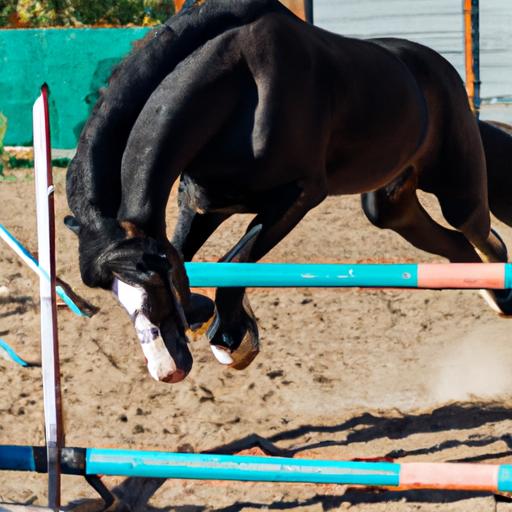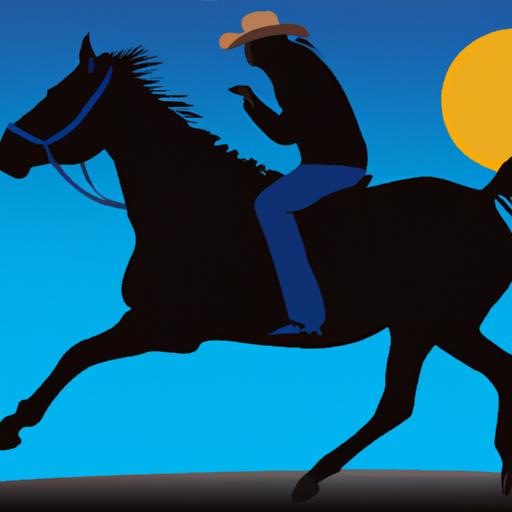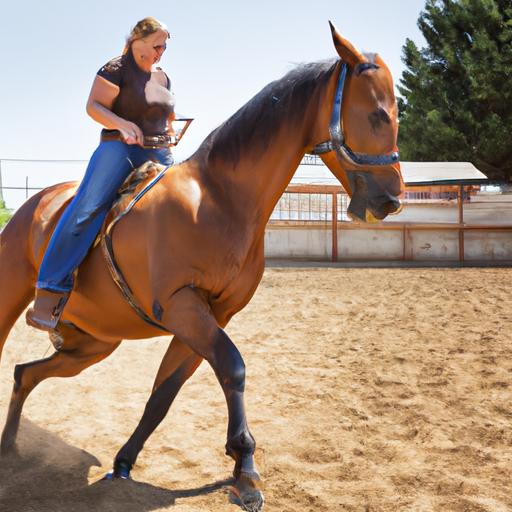Unlock the Potential of Your Equine Partner with volte horse training. Enhance coordination, flexibility, and trust between horse and rider. Discover the art of Volte Training today!
Introduction to Volte Horse Training

When it comes to training our beloved horses, we are constantly searching for innovative methods that not only enhance their skills but also strengthen the bond between horse and rider. One such approach that has gained popularity in recent years is Volte Horse Training. In this article, we will dive into the fascinating world of Volte Training, exploring its definition, significance, and how it has evolved over time.
A. Definition and Concept of Volte Horse Training
Volte Horse Training revolves around the idea of circular movements, where the horse and rider engage in a series of structured exercises within a specific radius. This technique encourages the horse to develop balance, suppleness, and responsiveness, ultimately leading to improved overall performance. By utilizing these circular patterns, riders can enhance the horse’s coordination and flexibility, resulting in a harmonious partnership between horse and rider.
B. Importance and Benefits of Volte Horse Training
Why should you consider incorporating Volte Horse Training into your equine routine? The benefits are truly remarkable. Firstly, this training method aids in building trust and communication between you and your horse. Through the repetitive nature of circular movements, horses gradually become more attuned to their rider’s subtle cues, establishing a deeper level of understanding and connection.
Moreover, Volte Training promotes physical fitness and mental stimulation for your horse. The circular patterns encourage the horse to engage their core muscles, improve their balance, and refine their coordination. As a result, horses become more agile, responsive, and better equipped to handle various equestrian disciplines.
C. Brief History and Evolution of Volte Horse Training
To fully appreciate the significance of Volte Horse Training, it’s essential to explore its historical roots. This training method traces its origins back to classical horsemanship, where it was used as a fundamental exercise to develop the horse’s collection and maneuverability. Over time, Volte Training has evolved and adapted to the modern equestrian world, incorporating elements from various disciplines, such as dressage and jumping.
In conclusion, Volte Horse Training offers a unique and effective approach to cultivating a well-rounded equine partner. By understanding the principles, benefits, and historical context of this training method, you’ll be well-equipped to embark on a rewarding journey of partnership and growth with your horse. So, let’s delve deeper into the essentials of Volte Training and discover the transformative potential it holds for you and your equine companion.
Understanding the Basics of Volte Horse Training

Volte Horse Training is a comprehensive approach that requires a solid understanding of its key principles, proper equipment, and safety considerations. In this section, we will explore these essential aspects, ensuring that you have a strong foundation before diving into the world of Volte Training.
A. Key Principles and Techniques Involved in Volte Horse Training
To succeed in Volte Horse Training, it’s crucial to grasp the fundamental principles and techniques that underpin this training method. One key principle is establishing clear and consistent communication with your horse. This involves using precise cues and aids to guide your horse through the circular movements, ensuring they understand and respond appropriately.
Furthermore, understanding the concept of bend and flexion is vital in Volte Training. By encouraging your horse to bend their body around the circle while maintaining a soft and supple connection, you promote better balance, engagement of the hindquarters, and overall harmony between horse and rider.
Another technique commonly employed in Volte Training is the use of transitions. Incorporating transitions between gaits or within the same gait helps develop the horse’s responsiveness and adjustability, making them more attentive and reactive to your aids.
B. Equipment Required for Volte Horse Training
While Volte Horse Training does not require elaborate or specialized equipment, having the right tools can enhance the effectiveness of your training sessions. One essential piece of equipment is a well-fitted and comfortable bridle, allowing you to maintain clear communication with your horse through the reins.
Additionally, using a suitable saddle that provides proper support and freedom of movement for your horse is essential during Volte Training. The saddle should distribute your weight evenly and allow your horse to move freely without any restrictions.
C. Safety Measures to Consider During Volte Horse Training
Prioritizing safety is paramount in any equestrian activity, including Volte Horse Training. Always ensure that you and your horse are wearing appropriate safety gear, including a well-fitting helmet and sturdy riding boots.
When starting out with Volte Training, it’s advisable to work in a controlled environment such as an enclosed arena or round pen. This provides a safe space for both you and your horse to focus on the training without distractions or potential hazards.
Moreover, remember to warm up your horse properly before engaging in Volte Training. A thorough warm-up routine helps prevent injuries and prepares your horse physically and mentally for the training session ahead.
By understanding the key principles, essential equipment, and safety measures involved in Volte Horse Training, you’ll be well-prepared to embark on your training journey. So, let’s move forward and explore the step-by-step guide to effectively implement Volte Training with your equine partner.
Step-by-Step Guide to Volte Horse Training

Volte Horse Training may seem intricate at first, but fear not! In this section, we will provide you with a comprehensive step-by-step guide to help you navigate through the training process smoothly.
A. Preparing the Horse for Volte Training
Before diving into Volte Training exercises, it’s crucial to ensure that your horse is physically and mentally ready. Take the following steps to prepare your equine partner for this transformative training:
-
Assessing the Horse’s Fitness and Readiness: Begin by evaluating your horse’s overall health and fitness level. Check for any underlying health issues or injuries that may hinder their ability to perform Volte exercises. Consult with a veterinarian or equine professional to ensure your horse is in optimal condition.
-
Establishing Trust and Rapport with the Horse: Building a strong bond with your horse is essential for successful Volte Training. Spend quality time grooming, lunging, and engaging in groundwork exercises to establish trust and establish a solid foundation of communication between you and your equine companion.
B. Introduction to Volte Training Exercises
Once your horse is prepared, it’s time to introduce them to Volte Training exercises. Start with the basics and gradually progress to more complex movements. Follow these steps:
-
Teaching the Horse to Respond to Basic Commands: Begin by reinforcing fundamental commands such as halt, walk, and trot. Use clear verbal cues and gentle aids to guide your horse’s responses. Consistency and patience are key during this stage.
-
Introducing the Horse to Circular Movements: Once your horse is comfortable with basic commands, introduce circular movements. Begin with larger circles and gradually decrease the radius as your horse becomes more proficient. Focus on maintaining a steady rhythm and encouraging your horse to engage their core muscles.
C. Progressive Volte Training Techniques
As your horse becomes more adept at Volte exercises, it’s time to introduce progressive techniques to enhance their skills further. Consider the following steps:
-
Increasing the Complexity of Commands and Movements: Challenge your horse by introducing more intricate commands and movements. Incorporate lateral work, such as leg-yields and shoulder-ins, to improve their balance and suppleness. Gradually increase the difficulty to keep your horse engaged and motivated.
-
Incorporating Transitions and Direction Changes: To further develop your horse’s responsiveness, incorporate frequent transitions and direction changes within the circular movements. This will help refine their coordination and obedience, ensuring a more seamless partnership between you and your equine companion.
D. Refining the Horse’s Skills in Volte Training
In this final stage of Volte Training, the focus is on fine-tuning your horse’s balance, coordination, flexibility, and agility. Follow these steps to refine their skills:
-
Fine-tuning the Horse’s Balance and Coordination: Engage in exercises that encourage your horse to maintain a balanced and collected frame. Incorporate lateral movements, such as leg-yields and half-passes, to improve their ability to carry themselves with grace and precision.
-
Enhancing the Horse’s Flexibility and Agility: Introduce exercises that promote greater flexibility and agility in your horse. Incorporate serpentines, figure eights, and spiral circles to encourage suppleness and adaptability in their movements.
By following this step-by-step guide, you’ll be well on your way to mastering Volte Horse Training. Remember, patience, consistency, and a mutual understanding with your horse are the keys to success. So, let’s embark on this transformative journey together, unlocking the true potential of your equine partner.
Common Challenges and Solutions in Volte Horse Training
Volte Horse Training, like any other training method, comes with its own set of challenges. However, with patience, understanding, and the right approach, these obstacles can be overcome, leading to a more successful and rewarding training experience. In this section, we will explore some common challenges faced during Volte Training and provide practical solutions to address them.
A. Dealing with Resistance and Disobedience
It’s not uncommon for horses to exhibit resistance or disobedience during Volte Training. This can manifest as reluctance to move in a circular pattern, pulling against the reins, or even outright refusal to perform the requested movements. To tackle this challenge, it’s crucial to identify the underlying causes and address them accordingly.
One possible cause of resistance is a lack of understanding or confusion about the trainer’s cues. In such cases, it’s essential to go back to basics and reinforce the foundational commands. Patience, consistency, and clear communication are key. Break down the movements into smaller steps, rewarding the horse for each successful attempt, and gradually build up to the desired outcome.
B. Overcoming Fear and Anxiety in Horses during Volte Training
Fear and anxiety can hinder a horse’s progress in Volte Training. The circular patterns, unfamiliar movements, or the presence of other horses or objects in the training area can trigger these emotions. It’s essential to create a safe and supportive training environment to help your horse overcome these challenges.
Start by gradually introducing the horse to the training area and the circular movements. Allow them time to acclimate and build confidence at their own pace. Use positive reinforcement techniques, such as praise and treats, to associate the training with positive experiences. Additionally, incorporating desensitization exercises can help reduce anxiety and build trust between you and your horse.
C. Addressing Physical Limitations and Injuries in Horses
Horses, like humans, can experience physical limitations or injuries that may impact their ability to perform certain movements in Volte Training. It’s crucial to prioritize the horse’s well-being and work closely with a veterinarian or equine professional to ensure their safety and rehabilitation.
If your horse has a pre-existing condition or injury, consult with a professional to develop a modified training plan that accommodates their needs. Focus on exercises that promote strength, flexibility, and rehabilitation, while being mindful of any limitations or discomfort. Regular veterinary check-ups and appropriate rest periods are essential to monitor progress and prevent further injury.
By addressing these common challenges head-on and implementing appropriate solutions, you can navigate through the hurdles of Volte Horse Training and create a positive training experience for both you and your equine companion. Remember, every horse is unique, and a tailored approach will yield the best results, ensuring a successful journey towards a harmonious partnership.
Advanced Techniques and Applications of Volte Horse Training
As you delve deeper into the world of Volte Horse Training, you’ll discover its versatility and the multitude of applications it offers. Let’s explore some advanced techniques and how Volte Training can be integrated into various disciplines and training programs.
A. Utilizing Volte Training for Specific Disciplines
Volte Training can be seamlessly incorporated into specific equestrian disciplines such as dressage and jumping. In dressage, Volte exercises help horses develop collection, suppleness, and precision in their movements. By refining their ability to execute circles with finesse, horses become more adept at performing intricate dressage patterns and movements.
Similarly, in jumping, Volte Training enhances a horse’s agility, adjustability, and balance. The circular exercises improve their ability to navigate tight turns and approach jumps from different angles. By incorporating Volte Training into their routine, jumpers can enhance their performance and increase their chances of success in the ring.
B. Incorporating Volte Training into a Comprehensive Training Program
Volte Horse Training can serve as a valuable component of a comprehensive training program. By incorporating Volte exercises alongside other training techniques, you can create a well-rounded routine that addresses various aspects of your horse’s development. Whether you’re focusing on improving their athleticism, responsiveness, or overall connection with the rider, Volte Training can complement and enhance existing training methods.
Integrating Volte exercises into your training program also offers mental stimulation for your horse. The variety and challenges presented by circular movements keep their minds engaged, preventing boredom and enhancing their overall willingness to learn and cooperate.
C. Showcasing the Versatility and Benefits of Volte Training
Volte Horse Training is not limited to specific disciplines or arenas. Its versatility extends to various contexts, including trail riding, recreational riding, and even therapeutic horsemanship programs. The circular movements can be adapted to different terrains and environments, making Volte Training a valuable tool for improving the horse’s overall athleticism and confidence, regardless of the setting.
Furthermore, Volte Training offers numerous benefits beyond the physical. The harmonious partnership developed through Volte exercises fosters trust, communication, and mutual understanding between horse and rider. It creates a solid foundation that extends beyond the training arena, enhancing the overall quality of your equestrian journey.
In conclusion, the advanced techniques and applications of Volte Horse Training open up a world of possibilities for you and your equine partner. By incorporating Volte exercises into specific disciplines, comprehensive training programs, and diverse contexts, you can unlock your horse’s full potential and achieve a deeper level of connection and success in your equestrian pursuits. So, let’s continue our exploration of Volte Training and witness the remarkable transformations it can bring to your equine journey.


